Inbound vs Outbound: Which Sales Strategy Scales Fast? [2025 Edition]
Not every sales strategy delivers the same results for every business. How well a strategy works often depends on where a company is in its growth journey, the complexity of its products or services, and how quickly it needs to scale. That’s why it’s important to understand which approach thrives best with your business.
While some companies thrive by letting buyers come to them and nurturing trust, others win by going straight to decision-makers with bold, direct outreach. Figuring out which approach fits your company’s stage, goals, and growth plans can be challenging. However, you’re not alone
In this guide, we’ll break down the various shades of inbound and outbound sales. By the end, you’ll see not just the differences between the two, but also how they can work together to build a more powerful, balanced sales engine.
What are inbound sales?
Inbound sales is a unique selling strategy that involves attracting potential customers to your products or services. Here, your customers come to you, which makes it a pull instead of chasing. With valuable content that builds trust and offers genuine value, you establish yourself as an expert who offers advice to close sales.
Creating high-quality, relevant content that addresses your audience’s needs is key to generating inbound sales. This kind of content includes blogs, infographics, webinars, emails, videos, social media posts, referrals, or any form of valuable content that offers value.
An effective inbound sales strategy involves researching and understanding your target market, creating buyer personas, and delivering valuable content that addresses your audience’s interests and needs. As a result, you generate high-quality leads who are already attracted to your business and achieve a higher return on investment (ROI).
Inbound sales often rely on tools like:
- Email marketing platforms (Lemlist or Instantly.ai) to nurture leads.
- SEO and content tools like Ahrefs and SEMrush for optimizing online visibility.
- Content Management Systems (WordPress, Wix) to deliver valuable content
- Analytics tools (Google Analytics, Hotjar) to track buyer behavior.
- CRM systems (HubSpot, Salesforce, Freshworks) to manage customer relationships.
Together, these tools make it easier to attract, nurture, and convert leads seamlessly.
What are outbound sales?
Outbound sales is a proactive selling strategy where sales teams initiate contact with potential customers. Unlike inbound sales, where leads come to you, outbound sales push your message out to carefully targeted prospects through methods such as cold calls, emails, and LinkedIn outreach.
The key to success is targeting the right prospects based on well-defined criteria such as industry, company size, role, or expressed intent signals. With the right ICP and using data-driven research, outreach becomes focused on those most likely to benefit from your solution, making your efforts efficient.
But targeting alone isn’t enough. Personalization ensures your outreach feels relevant, not robotic. It stands out against generic mass messages as it builds trust. Combining targeted lists with personalized, multi-channel engagement sequences significantly boosts response and conversion rates, turning cold outreach into meaningful conversations.
To streamline and scale the outreach process while maintaining personalization, outbound sales relies heavily on various tools. These are:
- Prospecting tools for accurate and targeted lead lists (LinkedIn Sales Navigator, Expandi, Ocean.io, Apollo.io)
- Data enrichment tools to find prospects’ contact information (Clay, FullEnrich, Prospeo)
- Email outreach solutions for automated personalized email sequences and follow-ups (Lemlist, Reply.io)
- Email deliverability tools to improve inbox placement and reduce spam filtering (Instantly, Woodpecker)
- Appointment scheduling to automate meeting bookings (Calendly, Chili Piper)
- CRMs to manage contacts, track activities, and analyze pipeline (Salesforce, HubSpot, Freshworks)
- Automation workflows to create custom integrations and automate complex sales tasks (n8n, Make, or Zapier).
Inbound vs Outbound: How do they generate leads?
Lead generation methods can be grouped into two distinct approaches: pull (inbound) and push (outbound).
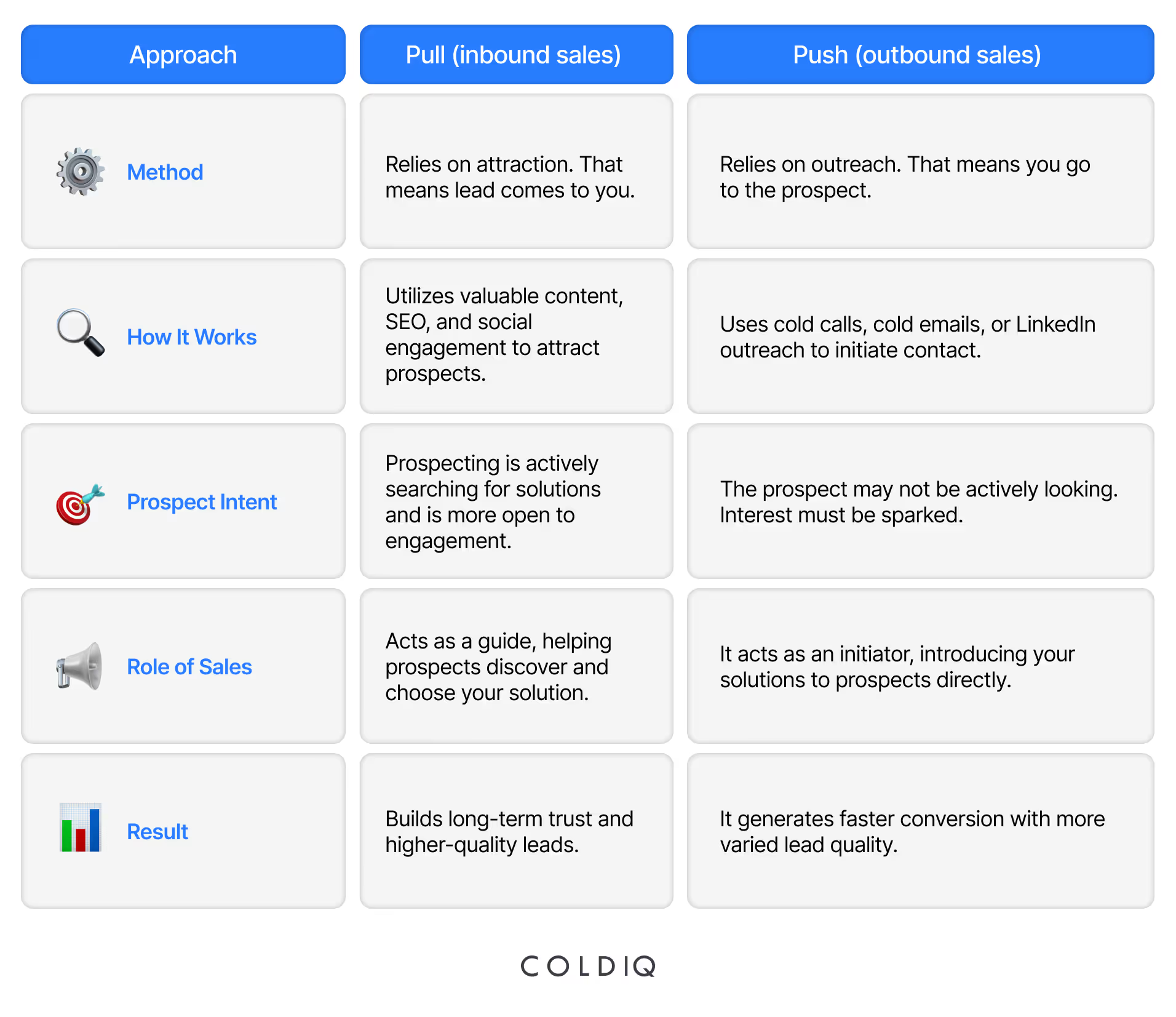
Inbound sales rely on attraction. Instead of going after prospects, they come to you. Here, businesses create valuable content, optimize for search engines, and use social media to attract potential customers.
The idea is to meet prospects where they already are, actively searching for information or solutions, and provide the right value that pulls them toward your brand.
Outbound sales, on the other hand, rely on outreach. Sales teams make the first move, proactively contacting prospects through cold calls, emails, ads, or direct messages. Here, the goal is to push your message to the right audience, creating awareness and sparking interest even if prospects haven’t shown intent yet.
Pros and cons of inbound lead generation
As inbound lead generation offers some benefits, there are also some drawbacks. Here are some pros and cons of inbound lead generation.
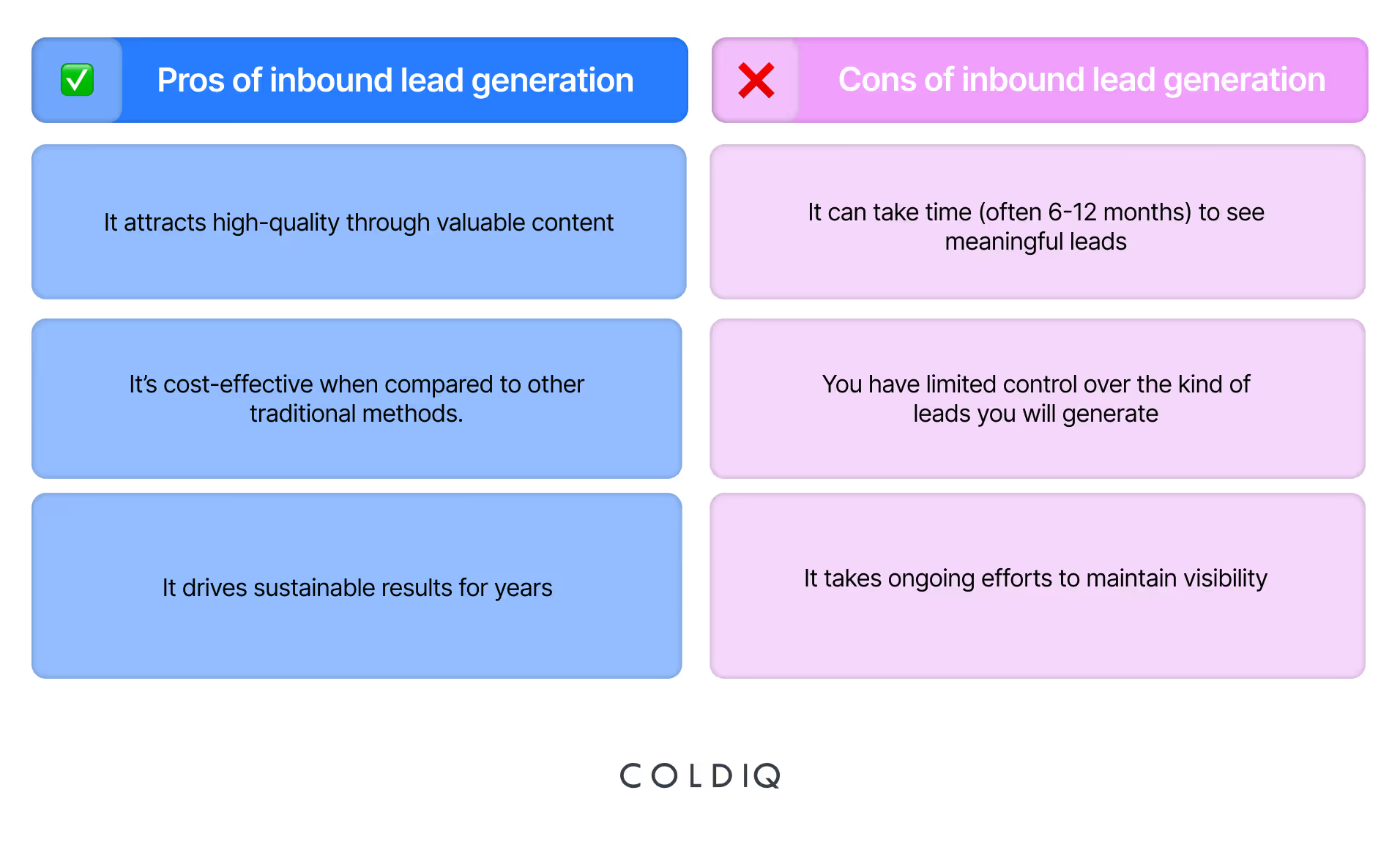
Pros and cons of outbound lead generation
Here are some advantages and disadvantages of outbound lead generation.
.avif)
Now that you know the pros and cons of each sales strategy, let’s look at which scales faster.
Which scales faster: inbound or outbound?
When it comes to generating leads, outbound sales generally scale faster in the short term. This is because sales teams are proactively reaching out through cold calls, cold emails, or targeted LinkedIn outreach, allowing businesses to quickly fill their pipeline.
Outbound works well for companies that need immediate conversations or want to test new markets, since the results depend more on the volume and targeting of outreach than on waiting for prospects to discover you.
However, inbound sales take a longer time to gain traction. Building valuable content, optimizing for search, and creating a strong brand presence is a gradual process. It requires consistency and time before prospects start finding you organically. But once inbound sales systems are in place, they generate a steady flow of high-quality leads at a lower cost.
For companies already generating over $100K in monthly revenue, outbound sales often scale quickly because they can afford to invest in larger prospecting teams, data tools, and automation.
With a well-defined ICP (ideal customer profile), these businesses can immediately launch targeted cold email campaigns, LinkedIn outreach, and sales calls, filling their pipeline fast.
ColdIQ is an example to help scale your outbound approach faster. Our sales experts leverage AI sales tools and unique sales strategies to generate qualified leads for companies earning over $100k per month.
Inbound sales, on the other hand, require time to develop authority and trust. Once it gains momentum, though, inbound provides more sustainable, cost-effective lead flow.
How do inbound and outbound fit into a B2B sales funnel?
A sales funnel is the marketing term for the journey potential customers go through on the way to purchase. The main goal of the sales funnel is to get the best results for your business.
If you want to avoid near misses and significant conversions, you'll need a strategic sales funnel. Here is an overview of the B2B sales funnel and the activities involved there.

Now, let’s go into the details.
1. Awareness
Inbound wins by attracting broad interest through content and organic discovery, thereby creating a strong brand presence without resorting to intrusive tactics. In outbound sales, you can target prospects and introduce your brand to high-value accounts faster.
2. Consideration
Inbound excels at nurturing and educating leads who have shown interest, using personalized content and engagement. Outbound personalization through persistent contact helps move less engaged leads forward.
3. Decision
Outbound typically works better here by driving direct sales conversations, overcoming objections, and closing deals quickly through live interaction. Inbound materials like testimonials and trials support validation, but usually don’t close alone.
The most effective B2B sales funnel leverages both inbound and outbound effectively. They use inbound marketing to build trust and nurture warm leads, then deploy outbound sales teams to engage proactively and close high-potential prospects identified via target lists.
How do costs compare between inbound and outbound?
When comparing inbound and outbound sales costs, the main difference is in where the money goes and how quickly returns show up. Inbound tends to be more cost-efficient, while outbound often requires a higher upfront investment to generate immediate results.
The cost of inbound sales
Inbound costs focus on creating and maintaining valuable content to attract leads. The cost of running inbound sales occurs in diverse ways, which include:
1. Content creation
Inbound sales requires you to create blog posts, publish videos, and craft social media content to attract and educate potential buyers. As a result, the expense typically comes from paying writers, designers, or videographers, or investing your team’s time in consistently producing quality material that builds trust.
2. SEO
SEO covers keyword research, link building, and technical optimization. If you want to drive traffic to your website, you need the right experts who are proficient in keyword research, link building, technical optimization, and so on. Research revealed that the cost of hiring an SEO agency from the US ranges between $2,500 to $10,000 per month.
3. Marketing tools
Inbound marketing tools scale operations. Whether it’s SEO tools, automation platforms, and content writing software, or email marketing solutions, these tools help you capture leads, nurture them with targeted campaigns, and track how effective your inbound strategy is. Their prices vary significantly, ranging from a few hundred dollars to thousands of dollars monthly.
The cost of outbound sales
Outbound costs often require a higher upfront investment to generate immediate results. You need some tools to make it work. But before getting to the expense, let’s look at some tools and their costs.

That said, here are the common expenses:
1. Prospecting tools
Outbound depends on having accurate data. Paid data sources and lead list providers help sales teams quickly access verified contacts of decision-makers, which saves time and reduces wasted effort.
2. Automation platforms
Cold email tools, sequencing platforms, and follow-up automation allow sales teams to send messages at scale while keeping outreach organized. These tools often come with monthly subscription fees.
3. Copywriting
Crafting effective cold email scripts and outreach templates is a cost on its own. Good copywriting makes a huge difference in whether prospects respond or ignore the message, so many companies invest in skilled writers or train their teams.
ROI expectation for inbound and outbound sales
Inbound usually delivers a higher ROI in the long run, because the assets you create — content, SEO, and brand authority — are compounded over time. Even though it takes longer to see results, inbound scales more sustainably and reduces cost per acquisition as your visibility grows.
Outbound, on the other hand, delivers faster but costlier results. It’s ideal for companies that need a pipeline quickly and have the budget to fund ongoing outreach. To scale outbound effectively, businesses must continuously invest in prospect data, personalization, and sales enablement tools. The ROI can be strong in the short term, but maintaining momentum requires consistent spending.
Companies that benefit from inbound and outbound sales strategies
Different companies in various industries benefit from inbound and outbound sales strategies in diverse ways. Before we get into the full details, here is an overview of how companies in different industries leverage inbound and outbound sales strategies to their advantage:
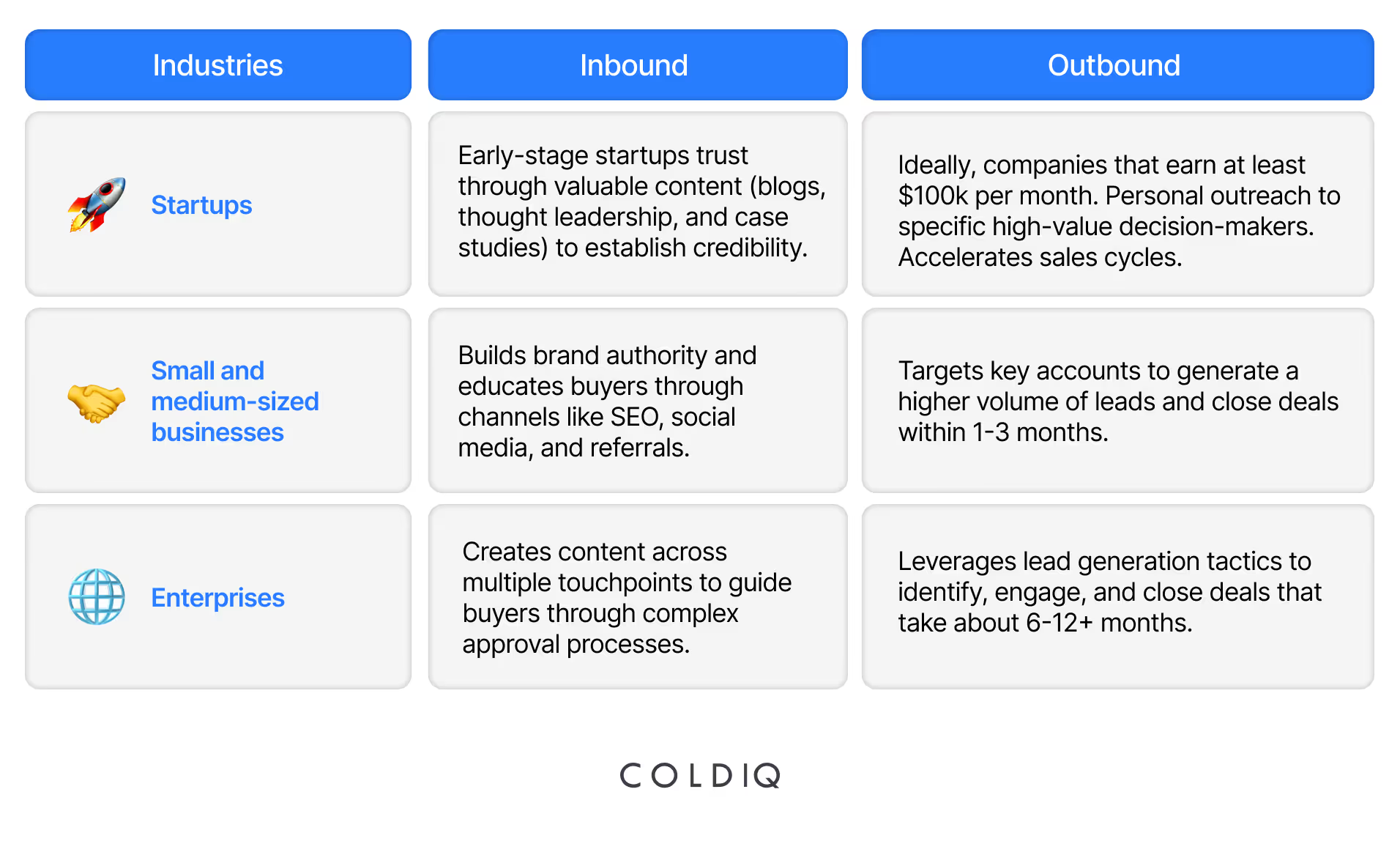
1. Startups
Startups, such as those in the early stages, benefit from inbound because they often need to build brand awareness and educate their market from scratch at a cost-effective rate.
Content-driven inbound marketing helps establish credibility organically, leaning on social selling tools like LinkedIn to connect with prospects and showcase thought leadership while their inbound engine builds momentum.
On the other hand, startups can leverage outbound sales strategies to directly contact high-value decision makers, generate leads, and obtain crucial feedback to refine their sales operations.
Ideally, these companies should earn at least $100k, have established products, and a steady cash flow, which allows them to invest in specialized outbound efforts.
With outbound sales automation tools and specialized experts, they can perform outreach at scale, ensuring teams can contact hundreds of prospects daily without losing personalization.
2. Small and medium-sized businesses (SMBs)
Small and medium-sized businesses operate on traditional models focusing on local markets, steady growth, and quick profitability. By utilizing inbound sales channels such as SEO, social media, and referrals, they build long-term relationships with their prospects to build brand awareness, improve loyalty, and drive business growth.
On the other hand, outbound sales strategies also work for SMBs. With tactical approaches and using the right sales prospecting tools, they generate a greater volume of leads that deliver higher ROI with lower CAC, all within 1-3 months.
3. Enterprises
Enterprises often have a longer sales cycle due to multiple stakeholders and complex approval processes. As a result, they take months to make purchasing decisions. Nonetheless, inbound sales methods support providing relevant content across multiple touchpoints to nurture leads patiently through complex evaluation processes.
On the other hand, outbound sales strategies leverage AI B2B lead generation tactics and relevant tools to identify, qualify, and close deals. They take a longer time (6-12+) months to close but offer a large contract which carries prestige and long-term value.
Can inbound and outbound work together?
Yes, you can combine inbound and outbound sales. For example, many companies have content marketing efforts, like a company blog, that’s consistently updated with useful information relating to their products or services. That’s an inbound sales tactic that pulls in leads who engage with the post.
Then, supplement your rep’s efforts via outbound sales strategies by adding leads to the pipeline. Research high-value prospects and contact them to see if they’re interested in your business’s offerings. Here’s a breakdown of how to combine inbound and outbound tactics in Clay.
1. Use Typeform to collect inbound lead data, especially their names and email addresses. All you do is search “Typeform” under the Actions tab, select “Import Typeform form responses,” input your Typeform account, and watch the table populate the Typeform responses as they come in.

2. Leverage the webhook in Clay to send the lead’s data to a table. Search “Webhook” and select “Pull in data from a webhook.” Copy the webhook URL and switch to the tool from which you want to collect the inbound leads. Add a new webhook and paste the Clay URL. This will send the data from the source to a Clay table.
3. Use Clay’s enrichment features to fill in the missing details. For instance, you can find firmographic data such as employee details, revenue, funding stage, tech stack, and company description. To do this, click “Actions” from your Clay table >> “View all enrichment.” Then, it will display various options from which you can choose.

4. Once you’ve enriched the leads, score them based on pre-defined criteria. You can also clean and normalize data for effective usage.
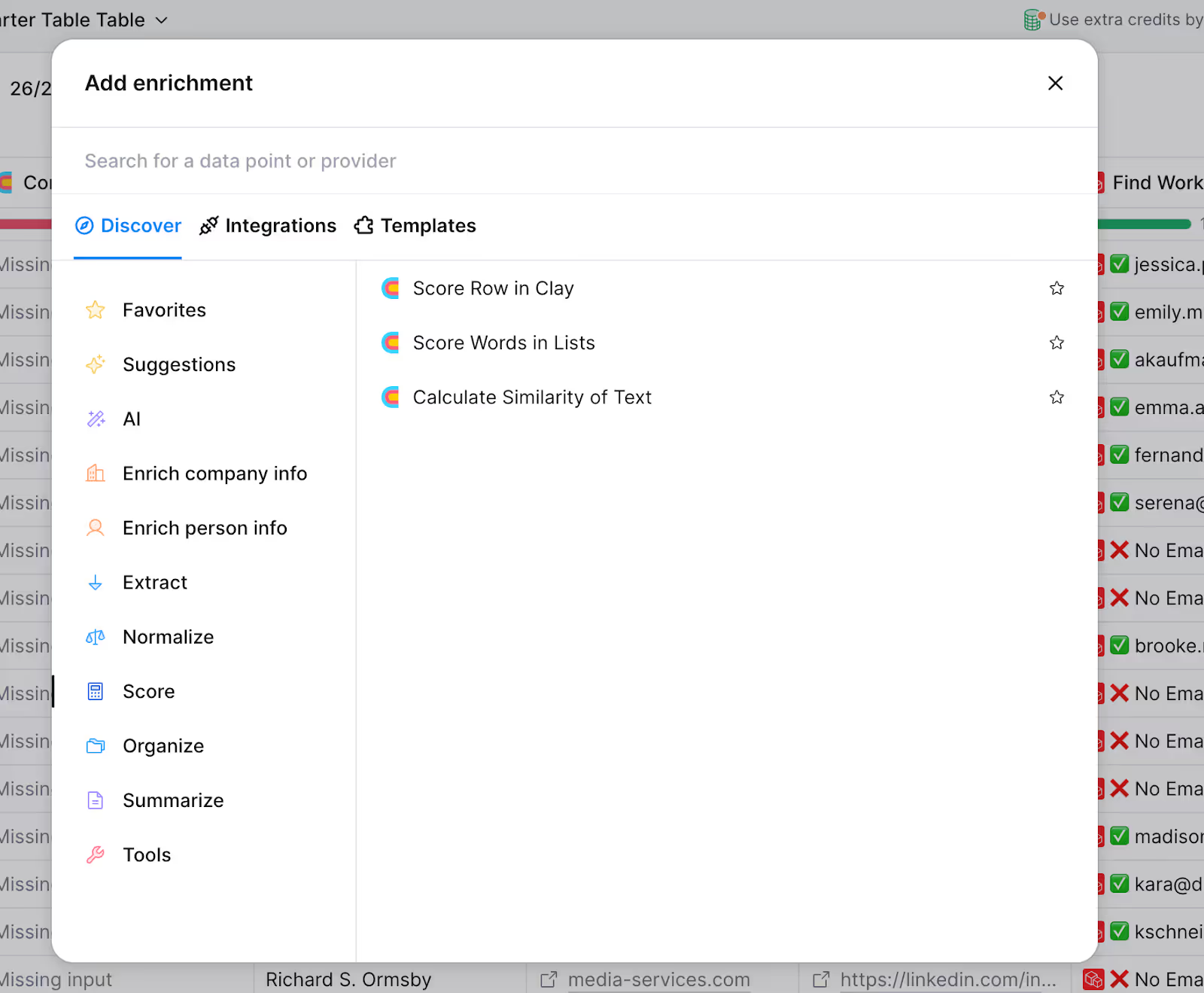
5. Once you’ve cleaned and normalize data, create personalized copy based on existing data in Clay.
6. Export your table to your CRM or any preferred outreach tool such as Lemlist or Instantly for further outreach activities. Lemlist is great for multichannel outreach to increase the chances of getting a response from your prospects.
Now, if this process seems to be a lot, let’s ColdIQ help you do the heavy lifting.
How does ColdIQ help with outbound sales?
If you struggle with generating qualified leads through outbound sales, ColdIQ can assist you by offering support throughout the entire outreach process. Whether it’s getting the most out of AI sales tools like Clay or offering practical guidance to your sales team, we are ready to help. Here is how we do that.
- Audience research: We perform research to identify your ICPs, define campaign goals, and establish the right performance metrics to track. We ensure our teams align with yours in terms of ICPs and messaging strategies, streamlining the foundation for successful outreach efforts.
- Targeting: We carry out extensive research to identify your potential customers. With AI sales tools and prospecting platforms like LinkedIn, we target relevant decision-makers who are more likely to show interest in your products or services to drive business growth.
- Copywriting: We leverage our prospects’ data to craft personalized, persuasive email sequences relevant to target audiences. This messaging emphasizes research-backed personalization, clear value propositions, and strong calls to action to maximize reply rates.
- Automation: To reduce administrative overhead for sales teams while ensuring timely and relevant communication, ColdIQ automates multi-channel outreach sequences to maintain consistent contact without manual effort.
- Inbox management: At ColdIQ, we set up your email infrastructure system to land your cold emails in prospects’ inboxes. We also manage your campaigns by sending qualified leads straight to you and re-engaging inactive accounts to encourage sales growth.
This sums up what we do. We also offer sales consulting services for firms and enterprises to find high-quality leads and drive business growth. In the next section, we will look at why you should work with us.
Why choose us?
With so many lead generation agencies out there, you may wonder, “Why choose us?” If you’ve pondered on these questions, here are some reasons:
1. Expertise and experience
At ColdIQ, we have the specialized skills and proven experience in outbound sales prospecting and leveraging the right tools to flood your pipeline with opportunities.
Whether it’s advanced tools like Clay or email delivery systems like Instantly, the goal is to create a scalable, sustainable cold emailing system that generates a steady flow of leads for your pipeline. We don’t just claim this. The result backs it up, as we doubled the demo rates for Design Pickles.
2. Scalability
We enable rapid scaling of sales efforts up or down based on business needs, seasonal demands, or market changes. Our sales team adjusts our strategies to meet fluctuating market demands without the need for alterations that could impact your pipeline.
3. Technological advantage
Our sales experts use cutting-edge sales technology that many businesses may not possess internally, such as CRM systems and automation platforms. With these tools, we gain data-driven insights to continuously refine and optimize your sales strategies.
What are common mistakes in inbound and outbound sales?
While both sales approaches have their unique methodologies, they also share common pitfalls that sales professionals should be aware of. Avoiding these mistakes can not only boost your performance but also improve your efficiency and effectiveness in closing deals.
Common inbound sales mistakes
Here are some common inbound sales mistakes to note.
1. Neglecting outreach
Many businesses assume that once they publish content, leads will automatically appear. But inbound works best when paired with proactive engagement. Relying solely on inbound lead generation without proactive engagement can let warm leads go cold.
To fix this, businesses should complement content marketing with light outreach, like personalized emails or social engagement, to bring attention to their resources and build momentum.
2. Poor nurturing
Another issue is poor lead nurturing. A prospect might download an eBook or sign up for a newsletter, but if there’s no follow-up, the interest fades quickly. The solution is to build relationships gradually with educational and value-driven content rather than pushing for quick closes.
You can also tailor nurturing sequences by segmenting leads based on behavior, interests, and buyer personas to keep content relevant and engaging.
3. Ignoring the value of the buyer persona
Successful inbound sales begin with a deep understanding of the buyer persona. Inbound often fails when the content attracts the wrong audience. This happens when businesses focus too broadly or create content just for traffic without aligning it to their ideal customer profile.
The fix is to craft targeted resources that address the pain points and needs of the right prospects, ensuring the leads you attract are more likely to convert.
Common outbound sales mistakes
Here are some common outbound sales mistakes to note for your team and business.
1. Spammy outreach
In outbound sales, a common error is relying on spammy outreach. Sending the same generic message to hundreds of people doesn’t just fail to generate results; it damages your brand reputation.
The solution lies in personalization, tailoring messages to prospects’ pain points, industry trends, or company context so they feel genuinely understood.
As Gerardo Teijeira, GTM Team Lead at ColdIQ, puts it, when an email is relevant, personalization can make all the difference and help you cut through the noise, differentiating your email from the hundreds of emails that prospects receive every day.
2. Poor targeting
Poor targeting is another pitfall. Reaching out to the wrong prospects wastes time and effort because those people may never need your solution. Without specific targeting, your outreach efforts can be inefficient and unproductive.
By narrowing your focus and targeting the right audience segments, you can significantly increase your chance of success. Sales teams should define their ICP clearly and use the right tools to filter leads by industry, role, or company size, ensuring outreach is directed at the right audience.
3. Lack of follow-up
Prospects rarely respond to the first touch, and stopping too soon leaves opportunities on the table. The solution is to design multi-step sequences across different channels like email, phone, and LinkedIn that steadily build familiarity and increase the chances of a response.
What are the latest trends in inbound vs outbound sales for 2025?
The latest trends in inbound vs outbound sales for 2025 focus heavily on advances in automation, AI, personalization, and multichannel engagement:
1. Automation advances & AI integration
Over 70% of sales teams use AI tools to quickly qualify, prioritize, and engage leads, enhancing productivity and close rates. AI-powered CRMs enable dynamic lead scoring and customized workflows for inbound nurturing, while outbound teams leverage AI for intent data analysis, predictive insights, and sequencing automation.
2. Hyper-Personalization in Outreach
Personalized messaging is a must-have in 2025, with tailored emails, LinkedIn messages, and video pitches to drive higher response rates. Sales reps use AI insights into buyer behavior and preferences to deliver contextually relevant content instead of generic outreach.
3. Multichannel & Omnichannel Engagement
Mixed-channel approaches combining email, phone, social, and video outreach outperform single-channel efforts, with higher conversion rates. Sales teams optimize touchpoints based on prospect preferences, balancing inbound content engagement with proactive outbound contacts.
Summary: inbound vs outbound sales strategy
Now that we’ve discussed all that relates to inbound and outbound sales strategy, here’s a quick recap.
- Inbound builds trust and attracts leads through content, SEO, and social channels. It’s slower to scale but creates long-term, sustainable growth.
- Outbound drives immediate conversations by directly targeting decision-makers. It’s faster to scale and creates predictable pipelines.
- Outbound often scales faster for established B2B companies because they already have steady revenue, tested offers, and resources to invest in automation, prospecting tools, and outreach campaigns. This allows them to expand quickly and hit growth targets without waiting months for inbound momentum.
That said, the most powerful approach is a strategic mix using inbound to nurture trust and outbound to accelerate pipeline growth. At ColdIQ, we build scalable outbound systems to ensure both sides are optimized, helping businesses scale smarter and faster. Book a GTM strategy call now!


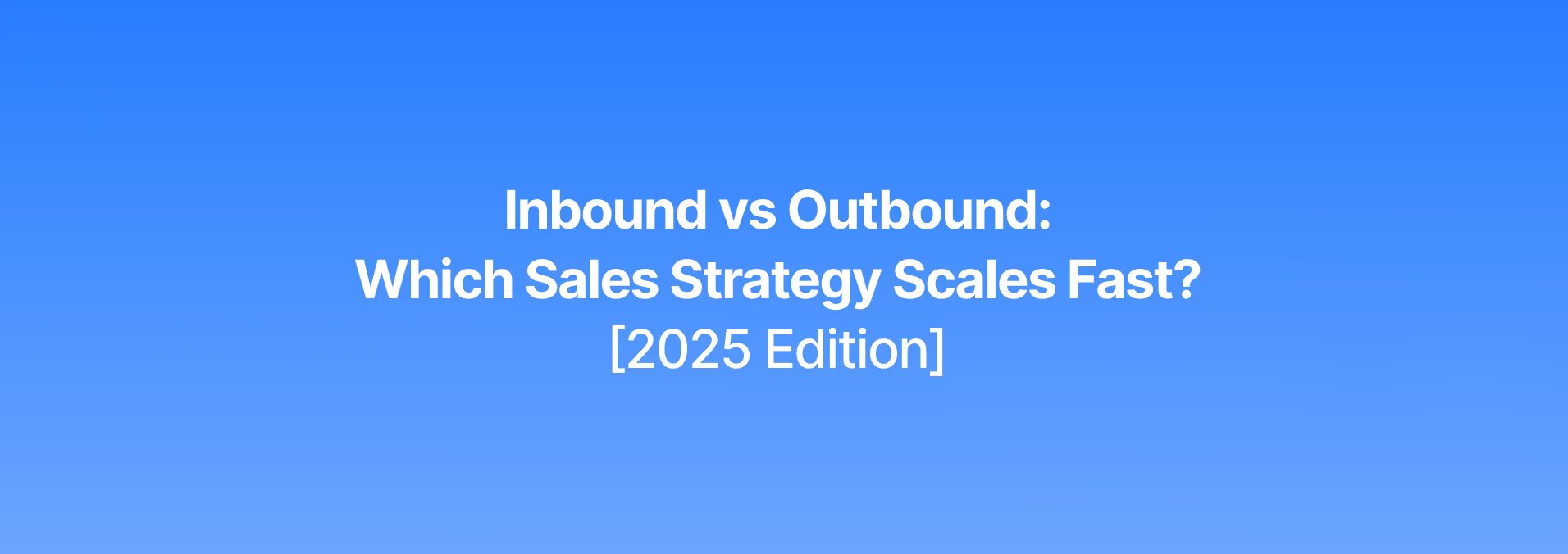

.avif)
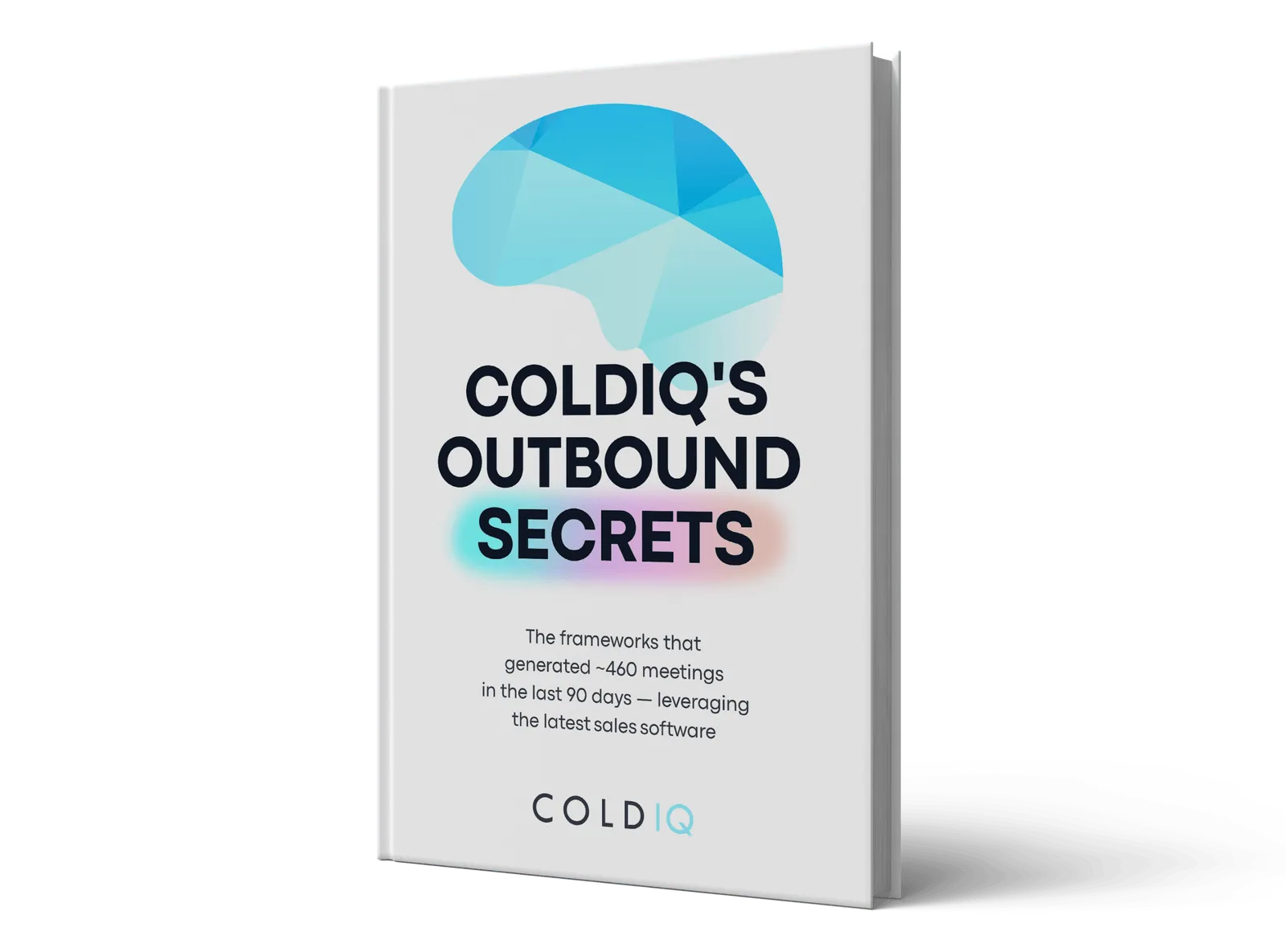
.svg)
.avif)
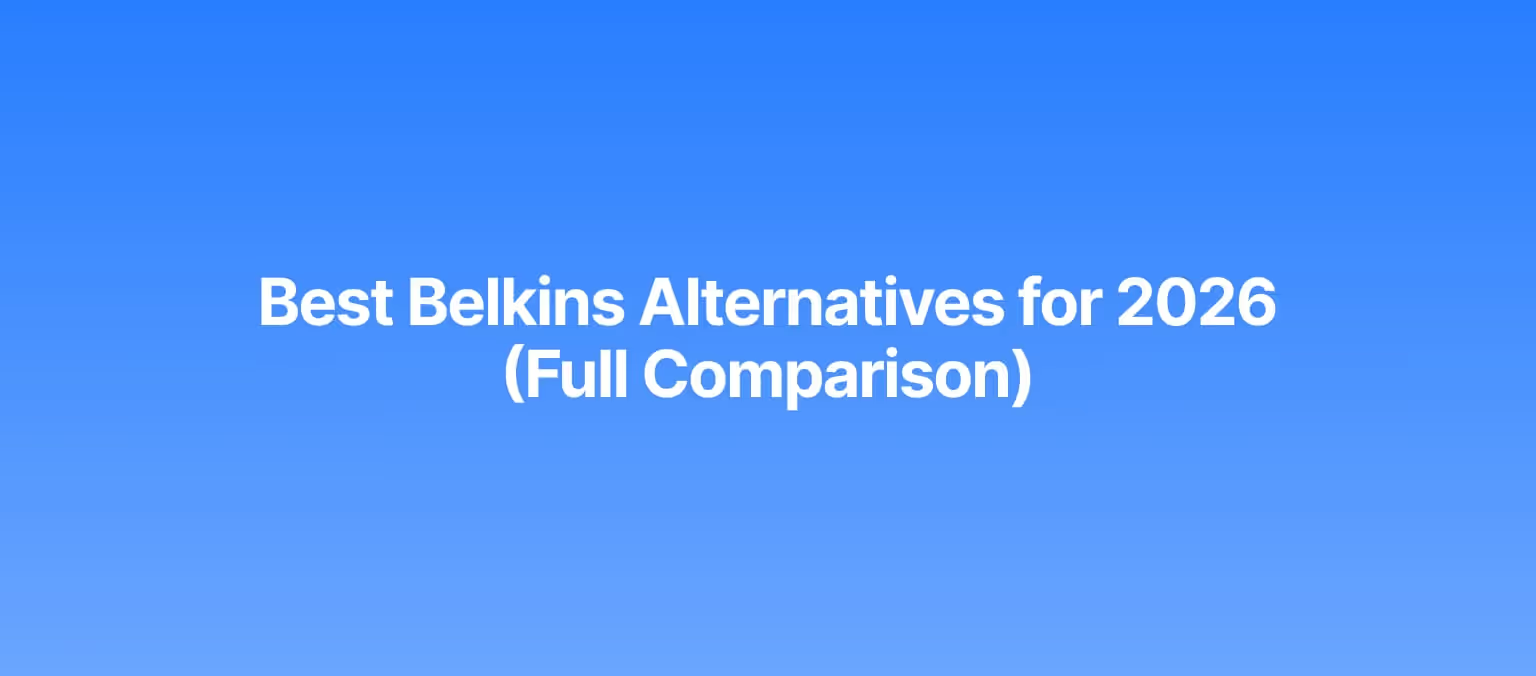
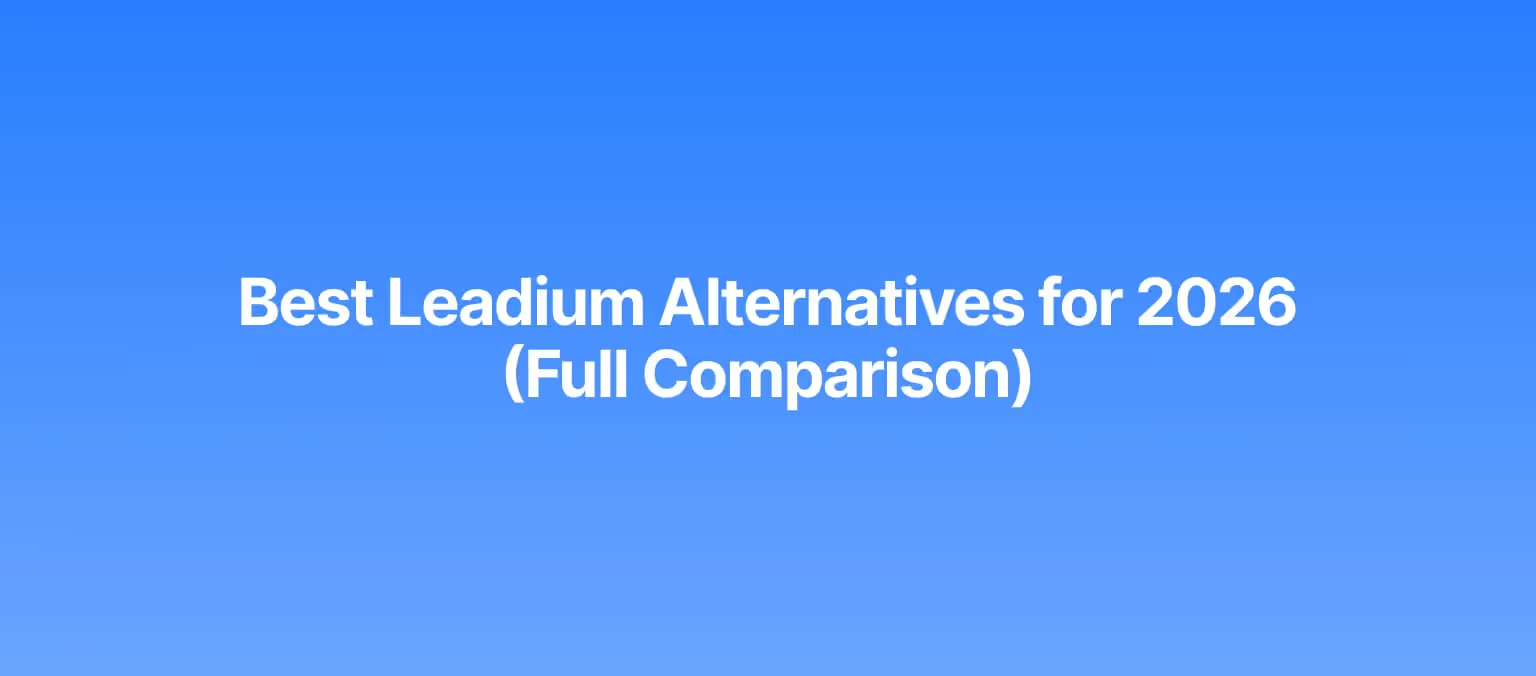

.avif)
